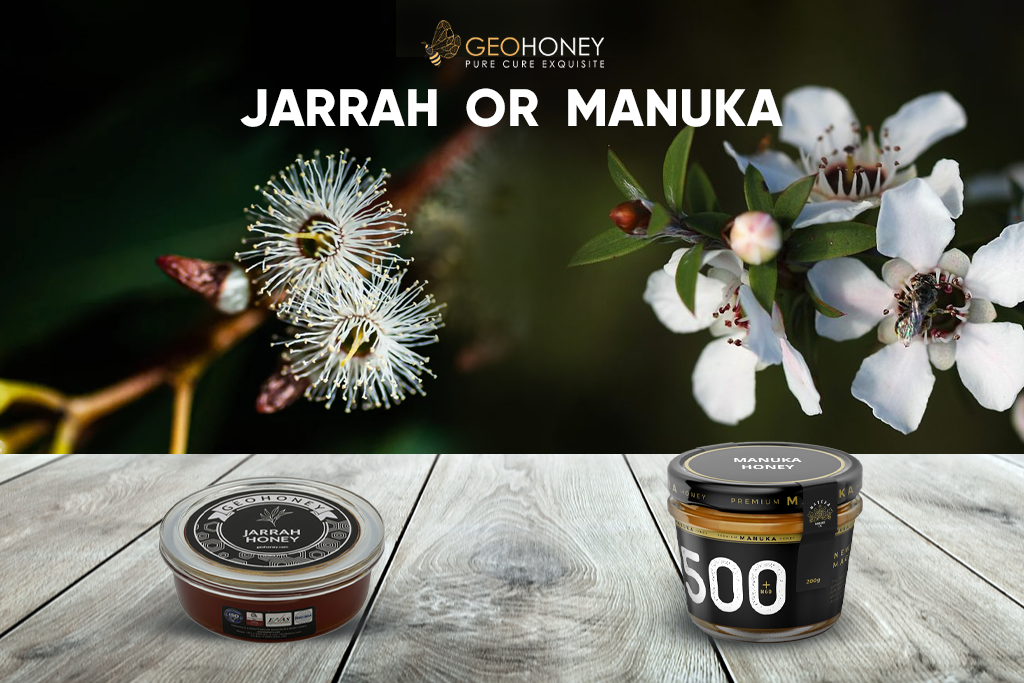- Tokyo: 22:53
- Singapore: 21:53
- Dubai: 17:53
- London: 13:53
- New York: 08:53
Manuka or Jarrah Honey? Let’s Compare the two best honey.

With the change in lifestyle and climate, people are becoming more aware of their health, as food they are consuming from the market is more chemically processed and artificial. Now they are looking back to the old food habits and alternatives of many processed foods. One among many is Honey, the alternative of Sugar. Although sweet sugar crystals, feels tasty, have their innumerable negative impacts. Therefore, people who are aware of the same are gradually turning towards natural honey which is one of the ancient foods available on earth and also known as super food. Honey is a primary food for honeybees, which is stored within the honeycombs present inside beehives. Moreover, honey contains monosaccharides like glucose and fructose. Only when consumed pure without any artificial additives, it works amazingly for the body. There are many honey varieties available in the market like monofloral honey and multifloral honey like avocado honey, almond honey, thyme honey, acacia honey, Jarrah honey, Manuka honey etc.
Manuka honey is one such common honey type available in the market with many claims. There is another honey type- Jarrah Honey, which claims to be quite similar to manuka honey and is also very popular in many parts of the world.
So we will find out the similarities and differences between Jarrah Honey & Manuka Honey below:
Plant source
Jarrah Honey is made from the Jarrah Tree (Eucalyptus marginata), whereas Manuka Honey is derived from the Manuka tree or you can say Leptospermum Tree. For honey to be categorised under Manuka honey officially, 70% or more pollen content in honey should be derived from the Manuka Tree itself. Whereas, if we talk about Jarrah Honey, it is derived exclusively from the Jarrah Tree, which is a kind of Eucalyptus tree, present mostly in Australia. The tree of Jarrah blooms every 2 years, from late spring to early summer. Jarrah Honey’s local origin and the best kind of healing abilities make it a valuable honey.
Sensory Profile
If we talk about viscosity, then Manuka is a little bit thicker in comparison to Jarrah honey. The Manuka Honey is somewhat dark brown to dark cream in colour. It has an aroma of damp earth-like, which is quite strong for the palette. Whereas in terms of taste, it is slightly bitter and of rich texture. Jarrah honey, on the other hand, delivers a subtle and beautiful smooth nutty-malt flavour, which is naturally and wonderfully sweet. Moreover, its colour is amber-like, with low glucose and a high concentration of fructose in it. Such features make Jarrah Honey an ideal choice to be used in desserts and other sweet dishes, by replacing sugar.
Health Benefits
Manuka honey has antibacterial and antimicrobial properties and is therefore used in different medical applications, like a natural remedy. As it is both anti-inflammatory and anti-viral, it can be used to prevent infections and treat wounds. Moreover, it also helps in soothing a sore throat, oral health, fighting acne, and soothing ulcers. However, Jarrah Honey has additional properties in comparison to Manuka Honey. Jarrah Honey consists of antibacterial, antifungal, and antimicrobial properties. Along with a high level of hydrogen peroxide, which can inhibit the Golden Staph Bacteria’s Growth. Its low glycemic index helps in preventing sore throats and ulcers. Moreover, this Jarrah Honey has the ability to efficiently and naturally heal skin infections, wounds, and minor burns.
|
S.No. |
Characteristic |
Jarrah Honey |
Manuka Honey |
|
1. |
Country of Origin |
Australia |
New Zealand |
|
2. |
Plant Source |
Jarrah Tree (Eucalyptus marginata) |
Manuka Tree (Leptospermum scoparium) |
|
3. |
Viscosity |
Low Viscous |
High Viscous |
|
4. |
Physical Properties |
Amber colour, Nutty Malt Flavor |
Dark cream to brown colour, Slightly bitter flavor |
|
5. |
Health Benefits |
Antibacterial & Antifungal, Heals wound, skin infection & burns |
Antibacterial, helps in Ulcer, sore throat |
To Conclude
The antimicrobial effects of Manuka Honey are caused by the presence of a substance named methylglyoxal. Moreover, this also means that Manuka Honey does not contain Hydrogen Peroxide and can be classified under the “non-peroxide” variety of honey.
Therefore, Manuka Honey is almost 50 percent less antimicrobial in comparison to Jarrah Honey. But, yes, it is still effective in the case of wound healing. When we talk about Jarrah Honey Properties, it acquires antimicrobial properties from the enzyme “Glucose Oxidase”, which is added with the help of bees while making honey. Also, the enzyme present in them reacts with oxygen and water, in order to produce hydrogen peroxide. The additional healing properties of this honey are all because of hydrogen peroxide. Lastly, Jarrah Honey contains almost thrice the number of antioxidants present in Manuka Honey, which further helps in supporting a healthy immune system.




Whether it is jarrah or manuka as long as we can get the benefits that we want, and it would be good for our body then, i'll go with this.
I've tried this jarrah honey and all I can is very palatable, which would make you try even more.